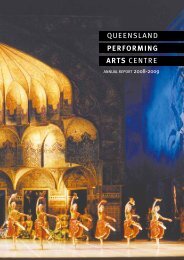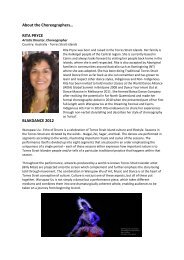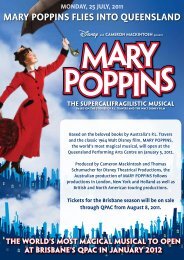Download - QPAC
Download - QPAC
Download - QPAC
You also want an ePaper? Increase the reach of your titles
YUMPU automatically turns print PDFs into web optimized ePapers that Google loves.
QUEENSLAND PERFORMING ARTS CENTRE AND EVENTS QUEENSLAND PRESENT<br />
BRISBANE EXCLUSIVE<br />
The Bright Stream<br />
Background<br />
Written by Valerie Lawson.<br />
Dancing farmers, a tractor driver, a man on a bicycle dressed as a dog and another in drag as a sylph in pointe<br />
shoes, all cavorting against a backdrop of golden sheaves of wheat on a collective farm.<br />
How could these be among the cast of characters in The Bright Stream, a ballet that first arose under the<br />
tyrannical leadership of Joseph Stalin?<br />
The transformation of this Soviet-era ballet of the 1930s into a joyous and comic ballet that has charmed<br />
audiences in Moscow, London and New York in the last decade is all due to one man, the acclaimed<br />
choreographer, Alexei Ratmansky.<br />
Born in St Petersburg and trained as a dancer in Moscow, Ratmansky is steeped in the history of Russian<br />
ballet and the work of Russian composers, and in particular, Dimitri Shostakovich. So in 1995 when he first<br />
heard the composer’s score for a long forgotten ballet, called The Limpid Stream, he was entranced.<br />
“It sounded incredible”, he said. “I couldn’t believe that no one had returned to it before. The music is just<br />
so danceable, with this wonderful variety of adagios, waltzes and polkas. It’s like [Ludwig] Minkus but all on<br />
the level of Shostakovich’s genius”.<br />
The choreographic notation of the 1935 ballet was nowhere to be found. But in 2003, using the original<br />
libretto and music, Ratmansky staged his reconstruction of the original Limpid Stream for the Bolshoi Ballet<br />
in Moscow.<br />
Renamed The Bright Stream, the ballet is set at a harvest festival at a collective farm in the north of Russia,<br />
complete with happy workers intermingling with a visiting troupe of ballet dancers from the city.<br />
Ballets featuring festival celebrations are not uncommon, (Coppelia, Flower Festival at Gennaro, for example),<br />
but a collective farm festival was an extremely radical and in retrospect, a dangerous idea in the 1930s – even<br />
though the creators of The Limpid Stream – the librettist, Adrian Piotrovsky, the choreographer, Fyodor<br />
Lopokov and the composer, Shostakovich - had no idea at the time of the terrible outcome of Stalin’s<br />
collective farm project. The forced confiscation of individually owned private farms, an era known as “the<br />
second serfdom”, led to the exile or death of many farmers who resisted.<br />
With its witty scenario and danceable score, The Limpid Stream was a critical success when it premiered at<br />
the Maly Theatre in Leningrad. As Ratmansky recalled: “All the critics raved about new horizons opening up<br />
and about this being the first major success of Soviet ballet”.<br />
But in January 1936, when the ballet transferred to the Bolshoi Theatre in Moscow, the edifice came<br />
crumbling down on their heads.<br />
Continued
















